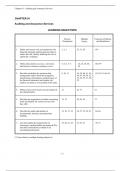Chapter 01 - Auditing and Assurance Services
CHAPTER 01
Auditing and Assurance Services
LEARNING OBJECTIVES
Review Multiple Exercises, Problems,
Checkpoints Choice and Simulations
1. Define information risk and explain how the 1, 2, 3 29, 31, 38 65*
financial statement auditing process helps to
reduce this risk, thereby reducing the cost of
capital for a company.
2. Define and contrast assurance, attestation, 4, 5, 6, 7, 8 23, 25, 28, 44, 60, 65*
and financial statement auditing services. 50
3. Describe and define the assertions that 9, 10, 11 36, 39, 40, 41, 45, 62, 63, 67, 68, 69
management makes about the recognition, 46, 47, 48, 49, 52,
measurement, presentation, and disclosure of 53, 54, 55, 57, 58,
the financial statements and explain why 59
auditors use them as a focal point of the audit.
4. Define professional skepticism and explain its 12 24, 37 61
key characteristics.
5. Describe the organization of public accounting 13, 14 30, 42, 56 72
firms and identify the various services that
they offer.
6. Describe the audits and auditors in 15, 16, 17, 18 26, 27, 32, 34, 35 64, 66
governmental, internal, and operational
auditing.
7. List and explain the requirements for 19, 20, 21, 22 33, 43, 51 70, 71
becoming a certified public accountant (CPA)
and other certifications available to an
accounting professional.
(*) Item relates to multiple learning objectives
1-1
.
, Chapter 01 - Auditing and Assurance Services
SOLUTIONS FOR REVIEW CHECKPOINTS
1.1 Business risk is the risk that an entity will fail to meet its business objectives. When assessing business
risk, a professional must consider all possible threats to an entity’s goals and objectives. Some illustrative
examples include the risk that: 1) its existing customers will start buying products or services from its
primary competitors; 2) its product lines will become obsolete; 3) its taxes will increase; 4) key government
contracts will be lost; 5) key employees will leave the entity; and many other examples exist.
1.2 To help minimize business risk and take advantage of other opportunities presented in today’s competitive
business environment, decision makers such as chief executive officers (CEOs) demand timely, relevant,
and reliable information. There are at least four environmental conditions that increase demand for reliable
information. First, complexity which implies that events and transactions in today’s global business
environment can be complicated. Most investors do not have the level of expertise needed to properly
account for complex transactions. Second is remoteness which implies that decision makers are often
separated from current and potential business relationships due to distance and time. For example, investors
may not be able to visit distant locations to check up on their investments. Third is time-sensitivity which
implies that in today’s economic environment, investors and other users of financial statements need to
make decisions more rapidly than ever before. As a result, the ability to promptly obtain high-quality
information is essential. Fourth is a consequence which implies that decisions may very well involve
significant investments. As a result, the consequences can be severe if information cannot be obtained
1.3 Of all the different risks discussed in the chapter up to this point, information risk is the one that is most
likely to create the demand for independent and objective assurance services is information risk or the
probability that the information circulated by an entity will be false or misleading. Because the primary
source of information for investors and creditors is the company itself, an incentive exists for that
company’s management to make their business or service appear to be better than it actually may be, to put
their best foot forward. As a result, preparers and issuers of financial information (directors, managers,
accountants, and other people employed in a business) might benefit by giving false, misleading, or overly
optimistic information. This potential conflict of interest between information providers and users which
provides the underlying basis for the demand for reliable information.
1.4 The four major elements of the broad definition of assurance services are
Independence. CPAs want to preserve their reputation and competitive advantage by always preserving
integrity and objectivity when performing assurance services.
Professional services. Virtually all work performed by CPAs is defined as “professional services” as long
as it involves some element of judgment based on education and experience.
Improving the quality of information or its context. The emphasis is on “information,” CPAs’ traditional
area of expertise. CPAs can enhance quality by assuring users about the reliability and relevance of
information, and these two features are closely related to the familiar credibility-lending products of
attestation and audit services. “Context” is relevance in a different light. For assurance services, improving
the context of information refers to improving its usefulness when targeted to particular decision makers in
the surroundings of particular decision problems.
For decision makers. As the “consumers” of assurance services, decision makers are the beneficiaries of the
assurance services. Decision makers may or may not be the “client” that pays the fee and may or may not
be one of the parties to an assertion or other information, but they personify the consumer focus of new and
different professional work.
1.5 An assurance services engagement is any assignment that improves the quality of information, or its
context, for decision makers. Because information (e.g., financial statements) are prepared by managers of
an entity who have authority and responsibility for financial success or failure, an outsider may be skeptical
that the information truly is objective, free from bias, fully informative, and free from material error,
intentional or inadvertent. The services of an independent auditor helps resolve those doubts because the
1-2
.




